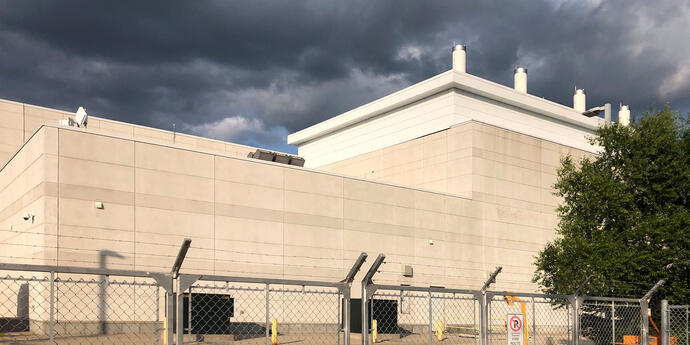
Servicing one of the largest banks in North America.
When it comes to the data centre of a multi-national financial services company, continuity of operations is the highest priority. This secure and reliable data centre design not only functioned for the Royal Bank of Canada (RBC) in the present, but was also scalable for future upgrades as the company grew.
Smith + Andersen was first engaged as the mechanical consultants on 75 Southgate during the original construction of the RBC Data Centre in 1991. More than a decade later, our mechanical team was engaged again for upgrades to the existing facility which were completed in 2008.
A solid base.
This data centre operates 24 hours a day, 365 days a year, so the design of the base building prioritized the redundancy of systems to prevent single source failures. Classified as a Tier 3 Data Centre, this building features multiple paths for power and cooling, with measures in place to update and maintain the systems without taking the facility offline.
The data centre features 60,000 square feet of white space, specifically for IT equipment and infrastructure, as well as 10,000 square feet of office space. Throughout the building, we designed and collaborated with other consultants to create solutions that included uninterruptible power supply (UPS) systems, diesel generators, and mainframe-chilled water-cooling systems. Our mechanical solutions are specific to the function of each space within the data centre. In the office area, our mechanical consultants designed variable air volume (VAV) handling units. In the computer area, we used constant volume ventilation air handling and self-contained computer room A/C units.
Bigger, better, faster, stronger (systems).
During the 2008 upgrades, the scope of our work included technical feasibility and arc flash studies. From these studies, we identified the necessary upgrades to existing systems, as well as the additional systems that were necessary. We then provided design services for these upgrades and additions, incorporating solutions that expanded the EPGS system and upgraded the existing UPS to 2,250kW, allowing for increased power density.
Servicing one of the largest banks in North America.
When it comes to the data centre of a multi-national financial services company, continuity of operations is the highest priority. This secure and reliable data centre design not only functioned for the Royal Bank of Canada (RBC) in the present, but was also scalable for future upgrades as the company grew.
Smith + Andersen was first engaged as the mechanical consultants on 75 Southgate during the original construction of the RBC Data Centre in 1991. More than a decade later, our mechanical team was engaged again for upgrades to the existing facility which were completed in 2008.
A solid base.
This data centre operates 24 hours a day, 365 days a year, so the design of the base building prioritized the redundancy of systems to prevent single source failures. Classified as a Tier 3 Data Centre, this building features multiple paths for power and cooling, with measures in place to update and maintain the systems without taking the facility offline.
The data centre features 60,000 square feet of white space, specifically for IT equipment and infrastructure, as well as 10,000 square feet of office space. Throughout the building, we designed and collaborated with other consultants to create solutions that included uninterruptible power supply (UPS) systems, diesel generators, and mainframe-chilled water-cooling systems. Our mechanical solutions are specific to the function of each space within the data centre. In the office area, our mechanical consultants designed variable air volume (VAV) handling units. In the computer area, we used constant volume ventilation air handling and self-contained computer room A/C units.
Bigger, better, faster, stronger (systems).
During the 2008 upgrades, the scope of our work included technical feasibility and arc flash studies. From these studies, we identified the necessary upgrades to existing systems, as well as the additional systems that were necessary. We then provided design services for these upgrades and additions, incorporating solutions that expanded the EPGS system and upgraded the existing UPS to 2,250kW, allowing for increased power density.
